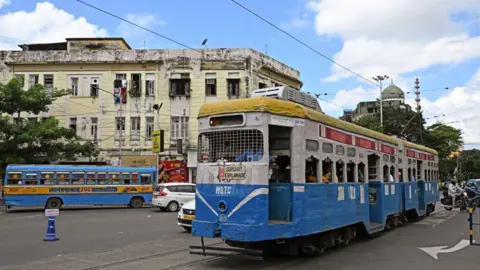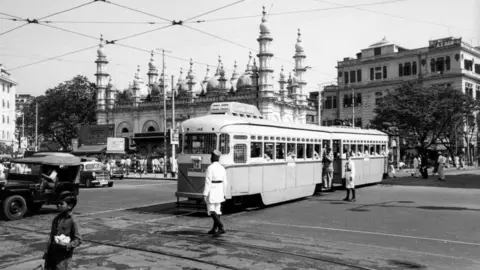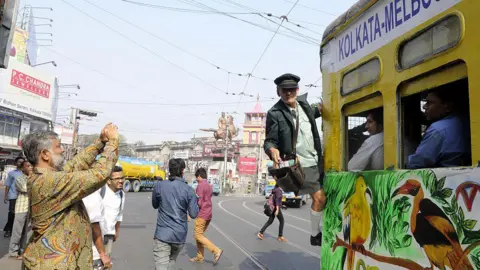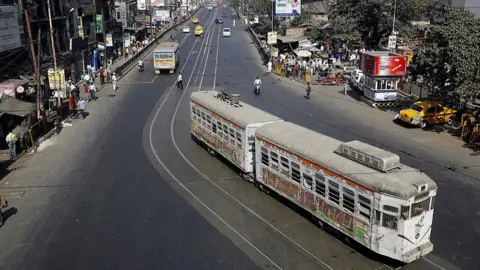 AFP
AFPLast week, authorities in the Indian city of Kolkata announced plans to eliminate trams entirely, retaining only a small heritage loop. In response, a group of activists is fighting to ensure that trams remain a vital mode of transport rather than mere nostalgic joyrides. Sandip Roy reports.
In February 2023, Kolkata celebrated 150 years of its tramways with music, cake, a beauty parade of vintage trams, including a century-old wooden car, and a cheerful tram conductor, Roberto D’Andrea, who travelled all the way from Melbourne, Australia.
Melbourne and Kolkata boast two of the oldest operational tramways in the world. Melbourne’s trams date back to 1885. Kolkata’s first tram, a horse-drawn one, started in 1873.
That’s where the similarities end.
Melbourne’s tram system is going strong despite the government once attempting to get rid of them. The system has been upgraded and some trams are solar-powered.
Kolkata’s trams have been steadily declining over the years. From 52 routes in the 1970s, down to 25 in 2015 and now to just three.
The tram cars rattle and wheeze, having not been updated in years. Even the signs inside have not changed. “Beware of pickpockets”, “No change available for 100 rupees ($1.19; $0.89) or 50” and “To stop the car please ring the bell only once”.
Now, the state government has announced that it wants to do away with trams entirely, save for one small loop as a heritage route.
But a dogged group of tram activists is fighting back.
“It’s a huge backward step as cities worldwide are ‘decarbonising transport’ because of global warming and climate change,” says Mr D’Andrea, who has helped foster a Kolkata-Melbourne tram friendship over the years.
“More than 400 cities run tram systems. Cities that dismantled their tramways are rebuilding them at great expense in places like Sydney and Helsinki and all over France. Hong Kong runs trams at high frequency on narrow streets,” he says.
But West Bengal transport minister Snehasis Chakraborty told the media: “The population and vehicular count of Kolkata have multiplied several times but the city’s roads have not widened. Road space continues to hover around 6% which is way less than Mumbai’s 18% and Delhi’s 10%.”
Both those cities once had trams. Mumbai had double-decker ones. Both have done away with them, leaving Kolkata as the only Indian city to hold onto the trundling streetcars.
In a way they have become emblematic of the city itself.
The city has other landmarks – the steel Howrah bridge, the white-domed Victoria Memorial monument, the colonial buildings in the city’s centre. But just as London has its iconic red double-decker buses, Kolkata has its trams. The ding-ding sound of the first tram of the day rattling down streets was the alarm clock many in Kolkata woke up to.
They are a familiar sight in films made in the state.
“I have used trams in two of my films and the tram depot as well,” says filmmaker Anjan Dutt.
Mahanagar (1963), by celebrated filmmaker Satyajit Ray, opens with a stunning two-minute-long tram sequence, sparks flying from the overhead cables before the camera moves inside to settle on the protagonist’s tired face as he returns home from work. Here, the tram stands in for the city itself, both its dreams and the daily grind.
In fact, Kolkata’s Belgachia tram depot, once bustling with workmen repairing, maintaining, even building trams, nowadays often doubles as a film set. “Even on a working day I saw films being shot in the workshop,” says Subir Bose, a tram company worker who retired in 2022 after 39 years of service. “A Kolkata film means they have to show a tram.”
 Getty Images
Getty ImagesTrams are very much part of the history of the city and its sense of itself.
In 1902, Calcutta as it was known then, became the first Asian city with electric trams. Even after independence, the Calcutta Tramways Company was run from London and was listed on the London Stock Exchange till 1968. The cars were built by companies with names like Burn Standard and Jessop.
And it wasn’t just a transportation system. The tram lines knit the city together.
When bloody Hindu-Muslim riots gripped Calcutta during partition in 1947, tram workers patrolled the city in empty trams to help restore normalcy.
“My own father helped save some people from a mob,” says tram driver Gopal Ram. “Tram workers were like a family. It didn’t matter if you were Hindu or Muslim.”
Mr Ram’s great grandfather Antu Ram was a tram employee from the steam-powered days. His grandfather Mahavir and father Jagannath worked for the trams as well. Mr Ram retired recently, the fourth and last generation of his family in Kolkata trams.
In some ways, the mystery is that Kolkata’s trams have survived this long.
“In the 1950s and 60s, during the personal automobile boom, people were getting rid of trams everywhere, not just in India,” says transport consultant Suvendu Seth.
“Now they are making a comeback. The light rail in many cities in the United States is just a newer version of trams. It’s sad that we had it all the time and are neglecting it instead of improving it.”
Mr Seth says that instead of complaining about lack of road space, an innovative solution could be to make some roads open only to pedestrians and trams.
 AFP
AFPDebashis Bhattacharyya, a retired academic and president of the Calcutta Tram Users Association, thinks trams survived in Kolkata all these years because they connected the city’s schools, hospitals and cinemas.
In the 1990s, as the count of cars and buses increased, the then Communist government in the state called trams “obsolete” and wanted to get rid of them.
“I protested,” says Mr Bhattacharyya. “If trams went, I felt my whole existence was threatened. I did exhibitions, slide shows, brought in foreign experts. The government should be applying for UNESCO heritage status for trams instead of trying to kill it off. ”
Recently, activists have been trying to use culture to save trams.
Since 1996, filmmaker Mahadeb Shi has been organising the Tramjatra festival, often in collaboration with Mr D’Andrea. Art students paint the trams and local bands perform in the streetcars.
Each Tramjatra has a theme, like Nobel laureate Rabindranath Tagore’s Gitanjali or the city’s Durga Puja festival.
“Tramjatra helped expose younger people to trams too,” says Shi.
One north Kolkata tram route was reopened recently. The West Bengal Transport Corporation also tried to make trams cool again with special projects like a tram library, an Independence Day special tram and a short-lived Tram World museum.
 AFP
AFPWhen Kolkata received a C40 Cities “Green Mobility” award in Copenhagen in 2019, mayor Firhad Hakim said trams were a key part of his vision to make the city’s transportation all-electric by 2030.
But now he seems to have forgotten that pledge. The government admits trams are a “green” mode of transport but says they are investing in other forms instead – electric buses and cars and expanding the underground metro system.
Mr Bhattacharyya says tram routes have been gobbled up by tuk-tuks which generate more employment and votes for the government. The tram depots also sit on valuable real estate the government can sell.
But Shi insists the final bell hasn’t rung yet, as the issue is now with the Calcutta High Court, which formed an advisory committee last year to explore how Kolkata’s tram services can be restored and maintained, with the state awaiting the committee’s report before taking further action.
Mr Bose, the retired tram worker, says the government could have shut down the trams long ago, but that something held it back every time. Perhaps because it too senses what trams mean for the city, he says.
“Three things made Kolkata Kolkata – the Howrah Bridge, the Victoria Memorial and the trams. It’s heart-breaking to think we could be losing one of them.”



